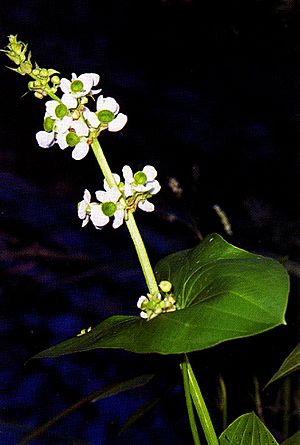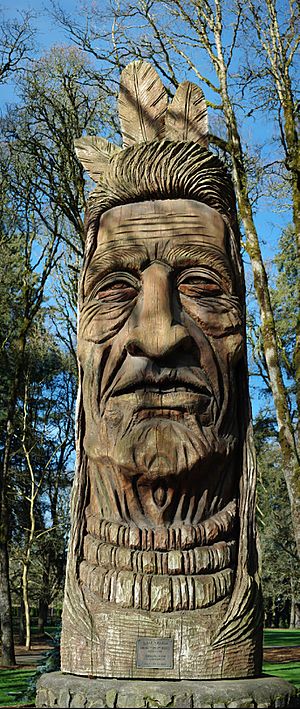Atfalati facts for kids
The Atfalati people were a group of Native Americans. They were also called the Tualatin or Wapato Lake Indians. They lived in what is now Oregon, in the northwest part of the United States. Their homes were in about 24 villages on the Tualatin Plains. They also lived near Forest Grove, Wapato Lake, and the North Yamhill River. The Atfalati were part of the larger Kalapuya group.
The Atfalati spoke a language called Tualatin-Yamhill. This language was one of the three main Kalapuyan languages.
Contents
Life and Traditions of the Atfalati People
The Atfalati people moved around their valley. They lived by hunting animals and gathering plants. This way of life is called "hunter-gatherer." Their main foods included deer, camas root, fish, berries, elk, and different kinds of nuts.
To help camas plants grow, the Atfalati would burn the valley floor. This also helped keep the land open for deer and elk. This was a common practice among the Kalapuya tribes.
Atfalati Clothing and Appearance
Before Europeans arrived, the Atfalati were known for their special decorations. They often wore red feathers on their heads. Both men and women had their earlobes and noses pierced. They would hang long beads and shiny dentalia (seashells) from these piercings.
The Atfalati also practiced a type of head flattening for babies. This was done more strongly than by people to their south. They also had fewer horses compared to tribes living east of the Cascade Range.
Atfalati Homes and Social Life
The Atfalati lived in large, rectangular houses. These homes were big enough for several families to live together. They also had slaves. Sometimes, a slave could buy their freedom using horses.
Changes and Challenges for the Atfalati
European-Americans started coming to the Atfalati homeland in the early 1800s. More settlers arrived in the 1840s. The arrival of these new people caused big changes for the Atfalati.
Impact of New Diseases
By the 1830s, the Atfalati had already started wearing some European-American clothes. But the biggest change was the spread of diseases. Many Native American populations in the Pacific Northwest were greatly reduced by illnesses. The Atfalati had already suffered from smallpox epidemics in 1782 and 1783.
These diseases made the Atfalati tribe much smaller. This made it harder for them to resist the new settlers. It is thought that the tribe had about 600 people in 1842. By 1848, their population had shrunk to only 60 people.
Treaties and Land Loss
By the 1850s, many white settlers were moving into the Willamette Valley. The United States government began to make treaties with the Kalapuya tribes, including the Atfalati. Anson Dart, who was the superintendent for Indian affairs in the Oregon Territory, led these talks.
On April 19, 1851, a treaty was signed. The Atfalati gave up their lands. In return, they were promised a small reservation at Wapato Lake. They also received money, clothing, blankets, tools, some rifles, and a horse for each of their leaders. At this time, there were 65 Atfalati people. This treaty meant the Atfalati lost most of their land. However, it was better than being forced to move east of the Cascade Mountains, which the government first wanted. But this treaty was never officially approved by the government.
Moving to the Grand Ronde Reservation
The government continued to pressure the tribes. So, a new treaty was negotiated with Joel Palmer, who took over from Anson Dart. This new treaty was called the Treaty with the Kalapuya, etc.. It was also known as the Willamette Valley Treaty or Dayton Treaty. It was signed on January 4, 1855, and approved by the United States Congress on March 3, 1855.
Under this treaty, the Native American peoples of the Willamette Valley agreed to move to a reservation. The government later chose the Grand Ronde reservation. This reservation was in the western part of the Willamette Valley, near the Oregon Coast Range. It became the permanent home for many different tribes.
After moving to the reservation, the Atfalati tribe continued to decline. The 1870 census showed 60 members living at Grand Ronde. The 1910 Census showed only 44. A report from 1914 listed only one Atfalati survivor living on the Yakama Indian Reservation in Washington. It is not fully known how much the Atfalati people blended in with the white settlers over time.
See also
 In Spanish: Atfalati para niños
In Spanish: Atfalati para niños



